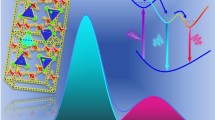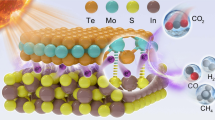Abstract
A novel terbium 2-hydroxymethyl-benzoimidazole-6-carboxylic acid complex has been designed and unique emission changes to fluoride anions in comparison with HSO −4 , AcO−, Cl−, Br−, and I− were observed. Then, the complex was encapsulated into an inorganic matrix. The novel hybrid material, with strong green emission was successfully synthesized as an anions receptor in water. More importantly, this hybrid material not only gave luminescence response to F−, but also to HSO −4 . Spectroscopic studies demonstrated that the recognition process for fluoride ions can be mainly ascribed to its hydrogen bonding interactions with hydrogen bond donor units (NH and OH). In case of hydrogen sulfate, the sensing effects can be probably attributed to its acidity instead of hydrogen bonding interactions.
Similar content being viewed by others
References
Bünzli, J. C. G., & Piguet, C. (2005). Taking advantage of luminescent lanthanide ions. Chemical Society Reviews, 34, 1048–1077. DOI: 10.1039/b406082m.
Dong, D. W., Jiang, S. C., & Men, Y. F., Jiang, S. (2000). Nanostructured hybrid organic-inorganic lanthanide complex films produced in situ via a sol-gel approach. Advanced Materials, 12, 646–649. DOI: 10.1002/(SICI)1521-4095(200005)12:9<646::AID-ADMA646>3.0.CO;2-W.
Gale, P. A., García-Garrido, S. E., & Garric, J. (2008). Anion receptors based on organic frameworks: highlights from 2005 and 2006. Chemical Society Reviews, 37, 151–190. DOI: 10.1039/b715825d.
Gunnlaugsson, T., Glynn, M., Tocci, G. M., Kruger, P. E., & Pfeffer, F. M. (2006). Anion recognition and sensing in organic and aqueous media using luminescent and colorimetric sensors. Coordination Chemistry Reviews, 250, 3094–3117. DOI: 10.1016/j.ccr.2006.08.017.
Kavallieratos, K., Bertao, C. M., & Crabtree, R. H. (1999). Hydrogen bonding in anion recognition: A family of versatile, nonpreorganized neutral and acyclic receptors. Journal of Organic Chemistry, 64, 1675–1683. DOI: 10.1021/jo982382l.
Parker, D., & Yu, J. H. (2005). A pH-insensitive, ratiometric chemosensor for citrate using europium luminescence. Chemical Communications, 2005, 3141–3143. DOI: 10.1039/b502553b.
Sambrook, M. R., Beer, P. D., Wisner, J. A., Rowena, L., Cowley, A. R., Szemes, F., & Drew, M. G. B. (2005). Anion-templated assembly of pseudorotaxanes: Importance of anion template, strength of ion-pair thread association, and macrocycle ring size. Journal of the American Chemical Society, 127, 2292–2302. DOI: 10.1021/ja046278z.
Santacroce, P. V., Okunola, O. A., Zavalij, P. Y., & Jeffery, T. D. (2006). A transmembrane anion transporter selective for nitrate over chloride. Chemical Communications, 2006, 3246–3248. DOI: 10.1039/b607221f.
Tan, C. L., Wang, Q. M., & Ma, L. J. (2010). Fluorescentbased solid sensor for HSO −4 in water. Photochemistry and Photobiology, 86, 1191–1196. DOI: 10.1111/j.1751-1097.2010.00795.x.
Thakurdesai, P. A., Wadodkar, S. G., & Chopade, C. T. (2007). Synthesis and anti-inflammatory activity of some benzimidazole-2-carboxylicacids. Pharmacologyonline, 1, 314–329.
Wang, Q. M., Tan, C. L., Chen, H. Y., & Tamiaki, H. (2010). A new fluoride luminescence quencher based on a nanostructured covalently bonded terbium hybrid material. Journal of Physical Chemistry C, 114, 13879–13883. DOI: 10.1021/jp105035v.
Zhang, Y. Y., Xue, Y. N., & Yu, M. (2011). Hydrothermal synthesis of core-shell structured PS@GdPO(4):Tb3+ /Ce3+ spherical particles and their luminescence properties. Chemical Papers, 65, 29–35. DOI: 10.2478/s11696-010-0088-5.
Author information
Authors and Affiliations
Corresponding author
Electronic supplementary material
Rights and permissions
About this article
Cite this article
Zhang, ZY., Wang, QM., Wu, JZ. et al. From a Tb3+ chelated compound to a hybrid material: selective emission responses to anions. Chem. Pap. 66, 221–225 (2012). https://doi.org/10.2478/s11696-011-0123-1
Received:
Revised:
Accepted:
Published:
Issue Date:
DOI: https://doi.org/10.2478/s11696-011-0123-1




